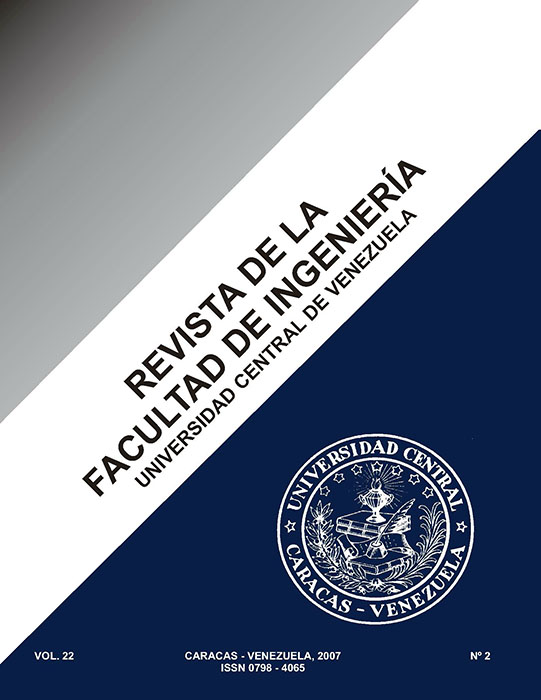MODELO ESTADÍSTICO QUE PERMITE INFERIR CONCENTRACIÓN DE POTASIO EN «COMPOST» PRODUCIDO A PARTIR DE DESECHOS ORGÁNICOS / STATISTICAL MODEL TO INFER POTASSIUM CONCENTRATIONS IN COMPOST PRODUCED BY ORGANIC WASTE
Palabras clave:
abono, diseño estadístico, respuestas, factores, superficie de respuesta.Resumen
Entre los problemas que debe afrontar y resolver satisfactoriamente la Universidad Central de Venezuela se encuentra elasociado al manejo de los desechos sólidos que allí se generan. En el Comedor Universitario como consecuencia de susactividades diarias se estimó una producción de desechos en el orden de 0,8 ton/día sólo en el área de la cocina del mismo.El manejo inadecuado de los desechos puede ocasionar la aparición de condiciones sanitarias inaceptables que conducenal deterioro del sitio de almacenamiento temporal. Entre las opciones universalmente aceptadas para minimizar estascondiciones, se encuentra la separación de aquellos de naturaleza orgánica para la preparación de abono («Compost»). Elobjetivo general del estudio fue elaborar un modelo de superficie de respuesta que permitiera estimar condiciones en laproducción de abono orgánico cuyo aporte de potasio fuera reproducible. En la producción de abono orgánico se utilizaronlos desechos sólidos generados en el área de la cocina del Comedor Universitario de la Universidad Central de Venezuelaen la Ciudad Universitaria de Caracas. La experiencia se planteó aplicando el diseño factorial fraccionado de Box-Behnken,utilizando los factores identificados y rangos de variación obtenidos en ensayos preliminares los cuales fueron: cantidadesagregadas de desechos (D), aserrín (C) y humedad agregada (A), así como el periodo de aireación (B). La respuesta seleccionada como indicador de aporte de nutriente fue el potasio. Ello permitió preparar una muestra de 29 abonosdiferentes, donde se combinaron los factores considerados de acuerdo al diseño mencionado. El modelo de superficie consistió en la obtención de una función matemática que es de la forma: y = β0 + βiXij + βij XiXj + β1X1i + εij , ↔ i = 1,2,3,4J = 1,2,3 donde y corresponde a la respuesta analizada, Xij corresponde al factor i nivel j, finalmente εij es el error aleatoriocorrespondiente a estas variables. Se obtuvo la ecuación correspondiente al modelo de superficie para la respuesta analizada (cantidad de potasio, y4) y se agrupan de la siguiente manera: y4 = 27,16 + 1,40A – 1,43B – 12,80C + 12,56D –0,51AB – 3,36AC – 4,92AD + 3,63BC -1,70BD – 5,47CD. Con la ecuación obtenida se optimiza hasta obtener el punto máximo. Esto último se logra empleando un método interactivo utilizando un software específico. Finalmente se logródiseñar un modelo que permite establecer las condiciones de mezcla inicial para preparar abono orgánico cuyo aporte depotasio se repite.
ABSTRACT
Among the problems that must be satisfactorily faced and solved by the Universidad Central de Venezuela concerns the handling of solid waste produced by the University itself. The University Dining Hall, to take one extreme example,produces as much as 0.8 tons of solid waste a day. The inadequate handling of solid waste can give rise to unacceptablesanitary conditions that entail the deterioration of the temporary storage site. Among the options universally accepted toavoid this is the separation of organic solid waste to prepare compost. The general objective of this work was to set up amodel that would allow us estimate conditions in the production of compost whose potassium contribution is reproducible.The solid waste generated in the kitchen of the University Dining Hall of the Universidad Central de Venezuela was used 84to make compost. The experiment consisted of the Box-Behnken fractionated factorial design using the factors identifiedand ranks of variation obtained in preliminary tests which were: solid waste (D), sawdust (C) and added humidity (A), as well as the period of aireation (B). The selected answer as an indicator of nutrient contribution was potassium. We thusprepared 29 different mixes of solid waste, where the factors considered according to the mentioned design were combined.The surface model consisted of obtaining a mathematical function of the form: y = β0 + βiXij + βij XiXj + β1X1i + εij, ∀ i = 1,2,3,4 J = 1,2,3 where y corresponds to the analyzed answer, Xij is the factor i level j, finally εij the random errorcorresponding to these variables. The equation corresponding to the model of surface for the analyzed answer (amount of potassium, y4) was obtained, grouped as follows: y4 = 27,16 + 1,40A – 1,43B – 12,80C + 12,56D – 0,51AB – 3,36AC – 4,92AD+ 3,63BC -1,70BD – 5,47CD. This equation is optimized until obtaining the maximum point. This is obtained using an interactive method with specific software. Finally, a model was designed that allows us to establish the conditions of initialmixture to prepare compost whose potassium contribution is repeated.
Keywords: compost, statistical design, answers, factors, surface answer.



